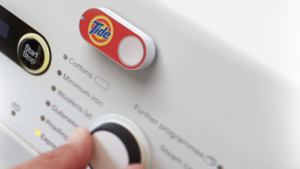Amazon recently announced that it will be partnering with over 50 additional brands in deploying its Dash buttons, small electronic buttons that can be sprinkled around the house and clicked to order the product a button represents. There are now more than 150 buttons available, covering products both ubiquitous (Doritos, Huggies, Gatorade) and niche (Greenies, L’il Critters Vitamins, Optimum Nutrition Gold Standard 100% Whey Protein).
 A Dash button in its intended deployment.
A Dash button in its intended deployment.From an engineering point of view, Dash Button is a curious creature. Other smart buttons, such as the Flic Wireless Smart Button, exhibit the design choices that an engineer would naturally come up with: a smart button is a small device with a replaceable coin cell battery, communicating over Bluetooth. If you come up to me, or any other engineer, and ask them to sketch on a napkin a smart button design, you’d get something like Flic.
Dash button, however, is something else entirely: its design creatively takes non-hardware needs into account. For example:
- Dash button is powered by a non-replaceable AAA battery (a teardown is available here); side note: the ads for the button make it seem thinner than it is (button’s commercial, its actual thickness). AAA battery is a curious choice for an energy source: many engineers would have tried to shrink the button by running it off a coin cell battery instead. Alas, Amazon had no need for shrinking: they want the button to take up space so that customers would see the Dash product’s logo.
- Dash button sends it information over WiFi; however, Dash button setup is completed via ultrasound. Yes, that’s right: there is a separate communication channel built into the button specifically for its setup. While in its normal operation, Dash button talks over WiFi to a home WiFi router, during its setup process, the button talks over its microphone to a smart phone. This is also not a solution that would come naturally to an engineer (huh? you want me to built in a microphone just for the setup process? instead of using what’s already there in WiFi?), but this is a solution that addresses many important concerns for Dash button operation. Since button’s settings cannot be changed over WiFi, you do not need to worry about your neighbors resetting the button. Since the button does not listen to WiFi signals, its battery cannot be drained by pinging it over WiFi.
Hat off to Amazon for a clever design that optimizes across hardware, software, and communications.
